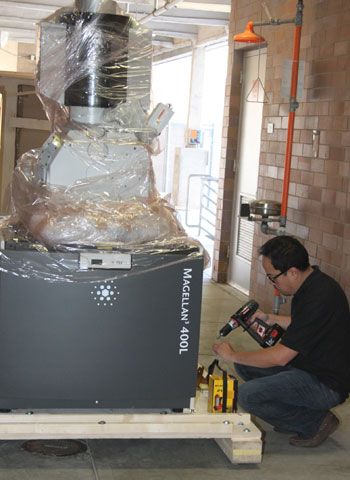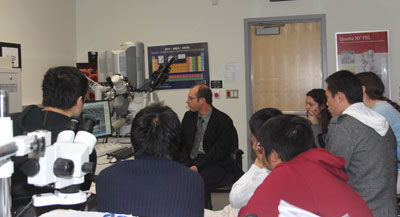New SEM Increases Imaging Capabilities
February 15, 2012 / By Anna Lynn Spitzer
|
A new ”extreme high resolution” scanning electron microscope (SEM) that provides sub-nanometer imaging capability was installed last month in the Calit2 Microscopy Center. The center is part of UCI’s materials characterization user facility, the Laboratory for Electron and X-ray Instrumentation (LEXI).
The FEI Magellan 400 is equipped with a magnetic immersion lens, and the latest backscatter and scanning transmission electron microscopy (STEM) detectors, as well as state-of-the-art spectroscopy and electron-beam lithography systems.
It also has a 5-axis piezoelectric stage for ultra-stable three-dimensional surface imaging, allowing researchers never-before-seen views of their materials.
The new instrument, funded by UC Irvine’s Office of Research, complements LEXI’s existing SEMs, giving UCI “the best SEM capabilities of any user facility in Southern California,” according to LEXI faculty director Matt Law.
“The Magellan is very powerful. It will enable users in physical sciences, engineering and biology to see, probe, and even make nanometer-scale features with unprecedented clarity and ease,” Law said.
The Magellan 400, along with the microscopy lab’s other FEI and Oxford instruments, was the focus of a recent training symposium held at Calit2 and organized by Jian-Guo Zheng, materials characterization director of operations. Attended by more than 60 current and potential users, the two-day session incorporated both lectures and hands-on exercises.
“Being able to hear about the physical theory in the lectures, then see it in action during the demo was a good way [to learn],” said attendee Matthew Sullivan, a chemical engineering and materials science graduate student.
|
Yixuan Lu, a chemistry graduate student, agreed. “They gave me a complete understanding of what the instrument can do via the lecture and how to do it via the demo,” he said.
Actual research projects were used in the hands-on demonstrations, bringing home the real-world capabilities of the lab’s high-tech instrumentation.
“I thought the topics covered were very relevant to the work being done at UCI,” chemistry graduate student Amanda Weber said. “The talks were very detailed and gave me some ideas for things I'd like to try.”
All of the microscopes and other instruments in the Microscopy Center and LEXI are available for use by academic and industry users on a recharge basis. Training sessions for the new Magellan SEM will be held later this month.
“This instrument will help researchers all over campus and at neighboring institutions achieve new breakthroughs in their work,” Law said.
-- Anna Lynn Spitzer



